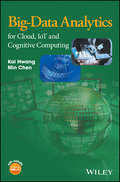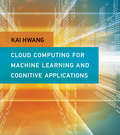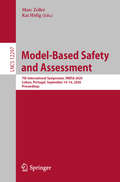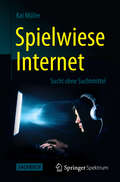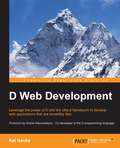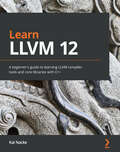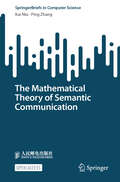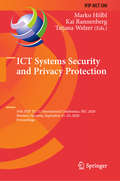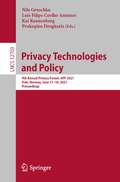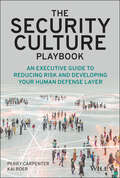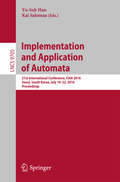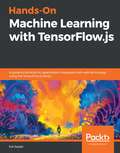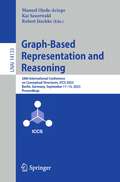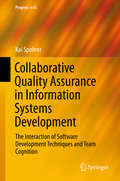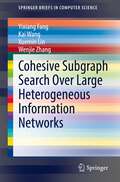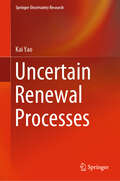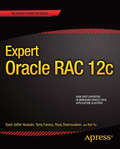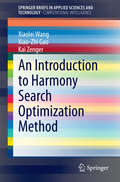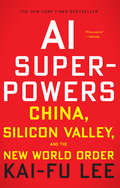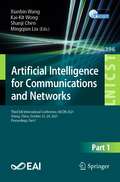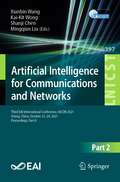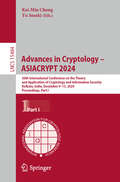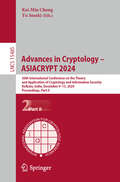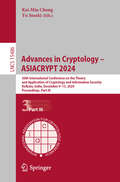- Table View
- List View
Big-Data Analytics for Cloud, IoT and Cognitive Learning
by Min Chen Kai HwangThe definitive guide to successfully integrating social, mobile, Big-Data analytics, cloud and IoT principles and technologies The main goal of this book is to spur the development of effective big-data computing operations on smart clouds that are fully supported by IoT sensing, machine learning and analytics systems. To that end, the authors draw upon their original research and proven track record in the field to describe a practical approach integrating big-data theories, cloud design principles, Internet of Things (IoT) sensing, machine learning, data analytics and Hadoop and Spark programming. Part 1 focuses on data science, the roles of clouds and IoT devices and frameworks for big-data computing. Big data analytics and cognitive machine learning, as well as cloud architecture, IoT and cognitive systems are explored, and mobile cloud-IoT-interaction frameworks are illustrated with concrete system design examples. Part 2 is devoted to the principles of and algorithms for machine learning, data analytics and deep learning in big data applications. Part 3 concentrates on cloud programming software libraries from MapReduce to Hadoop, Spark and TensorFlow and describes business, educational, healthcare and social media applications for those tools. The first book describing a practical approach to integrating social, mobile, analytics, cloud and IoT (SMACT) principles and technologies Covers theory and computing techniques and technologies, making it suitable for use in both computer science and electrical engineering programs Offers an extremely well-informed vision of future intelligent and cognitive computing environments integrating SMACT technologies Fully illustrated throughout with examples, figures and approximately 150 problems to support and reinforce learning Features a companion website with an instructor manual and PowerPoint slides www.wiley.com/go/hwangIOT Big-Data Analytics for Cloud, IoT and Cognitive Computing satisfies the demand among university faculty and students for cutting-edge information on emerging intelligent and cognitive computing systems and technologies. Professionals working in data science, cloud computing and IoT applications will also find this book to be an extremely useful working resource.
Cloud Computing for Machine Learning and Cognitive Applications
by Kai HwangThe first textbook to teach students how to build data analytic solutions on large data sets using cloud-based technologies. This is the first textbook to teach students how to build data analytic solutions on large data sets (specifically in Internet of Things applications) using cloud-based technologies for data storage, transmission and mashup, and AI techniques to analyze this data. This textbook is designed to train college students to master modern cloud computing systems in operating principles, architecture design, machine learning algorithms, programming models and software tools for big data mining, analytics, and cognitive applications. The book will be suitable for use in one-semester computer science or electrical engineering courses on cloud computing, machine learning, cloud programming, cognitive computing, or big data science. The book will also be very useful as a reference for professionals who want to work in cloud computing and data science.Cloud and Cognitive Computing begins with two introductory chapters on fundamentals of cloud computing, data science, and adaptive computing that lay the foundation for the rest of the book. Subsequent chapters cover topics including cloud architecture, mashup services, virtual machines, Docker containers, mobile clouds, IoT and AI, inter-cloud mashups, and cloud performance and benchmarks, with a focus on Google's Brain Project, DeepMind, and X-Lab programs, IBKai HwangM SyNapse, Bluemix programs, cognitive initiatives, and neurocomputers. The book then covers machine learning algorithms and cloud programming software tools and application development, applying the tools in machine learning, social media, deep learning, and cognitive applications. All cloud systems are illustrated with big data and cognitive application examples.
Model-Based Safety and Assessment: 7th International Symposium, IMBSA 2020, Lisbon, Portugal, September 14–16, 2020, Proceedings (Lecture Notes in Computer Science #12297)
by Marc Zeller Kai HöfigThis book constitutes the proceedings of the 7th International Symposium on Model-Based Safety and Assessment, IMBSA 2020, held in Lisbon, Portugal, in September 2020. The conference was held virtually due to the COVID-19 pandemic. The 15 revised full papers and 4 short papers presented were carefully reviewed and selected from 30 initial submissions. The papers are organized in topical sections on safety models and languages; state-space modeling; dependability analysis process; safety assessment in automotive domain; AI and safety assurance.
Spielwiese Internet: Sucht ohne Suchtmittel
by Kai MüllerInternetsucht ist eine moderne Form einer psychischen Problematik, die offensichtlich immer mehr Menschen etwas angeht, entweder direkt oder indirekt. Wie eine verschwommene Schimäre taucht dieses Schlagwort "Internetsucht" in den Medien auf. Zahlen von Betroffenen, Symptome und Auswirkungen dieses neuen Phänomens werden von unterschiedlichen Experten in unterschiedlicher Weise diskutiert und dennoch bleibt der Nicht-Fachmann nur allzu oft mit mehr Fragen als Antworten zurück. Dieses Buch soll dem Leser einen möglichst umfassenden Einblick vermitteln. Es vermittelt Antworten auf zentrale Fragen, wie z.B.: Was verbirgt sich hinter dem Begriff der Internetsucht? Wann ist ein Verhalten bereits Ausdruck einer Sucht? Welche Menschen sind als besonders gefährdet anzusehen? Welche Maßnahmen können ergriffen werden, um einer Internetsucht zu begegnen? Der aktuelle psychologische Kenntnisstand wurde hierzu nachvollziehbar aufbereitet und in einen engen praxisnahen Bezug gesetzt. Zielgruppen für dieses Werk sind alle, die sich über das Thema Spiel- und Internetsucht informieren möchten sowie alle, die selbst oder in ihrem familiären Umfeld oder Bekanntenkreis Menschen kennen, die davon betroffen sind. Nebenzielgruppe sind alle diejenigen, die im beruflichen Umfeld mit Betroffenen zu tun haben. Der Autor ist Diplompsychologe und arbeitet in der deutschlandweit einzigartigen Ambulanz für Spielsucht. Innerhalb seines beruflichen Umfeldes befasst er sich intensiv mit dem Thema der substanzungebundenen Abhängigkeitserkrankungen (Verhaltenssüchte), hier insbesondere mit der Internet- und Computerspielsucht sowie der Glücksspielsucht.
D Web Development
by Kai NackeLeverage the power of D and the vibe.d framework to develop web applications that are incredibly fast About This Book * Utilize the elegant vibe.d framework to build web applications easily and REST backends with the D programming language * Learn about all components of vibe.d to enhance your web development with D * A hands-on guide to the vibe.d framework; from static web pages to template-based, interactive and localized web applications with database access and REST backends Who This Book Is For Whether you are new to the world of D, or already have developed applications in D, or if you want to leverage the power of D for web development, then this book is ideal for you. Basic knowledge of core web technologies like HTML 5 is helpful but not required. This book explains the difficult details to speed your web development. What You Will Learn * Create amazingly fast web applications with D * Use Diet templates to easily create a web user interface * Utilize the web framework for interactive applications with input validation and internationalization * Access a database to provide persistent storage for your application * Extend your application with a REST interface and access other applications via REST * Understand vibe.d's fiber-based approach to asynchronous I/O and use it for integration of existing components * Create GUI applications with vibe.d In Detail D is a programming language with C-like syntax and static typing. The vibe.d framework builds on powerful D concepts like template meta-programming and compile-time function execution to provide an easy-to-use environment for web applications. The combination of a feature-rich web programming framework with a language compiling to native code solves two common issues in web development today: it accelerates your development and it results in fast, native web applications. Learning the vibe.d framework before you start your application will help you to choose the right features to reach your goal. This book guides you through all aspects of web development with D and the vibe.d framework. Covering the popular operating systems today, this guide starts with the setup of your development system. From the first Hello World-style application you will move on to building static web pages with templates. The concise treatment of web forms will give you all the details about form handling and web security. Using the abstractions of the web framework you will learn how to easily validate user input. Next, you will add database access to your application, providing persistent storage for your data. Building on this foundation, you will expose your component and integrate other components via REST. Learning about the internals of vibe.d you will be able to use low-level techniques such as raw TCP access. The vibe.d concepts can also be used for GUI clients, which is the next topic that you will learn. vibe.d is supported by an active community, which adds new functionality. This comprehensive guide concludes with an overview of the most useful vibe.d extensions and where to find them. It also shows you how to integrate these extensions in your application. The concepts are always illustrated with source code, giving you an insight into how to apply them in your application. Style and approach A tutorial-style guide to develop web applications with D and the vibe.d framework. Each topic is explained in detail and illustrated with source code, providing you with hands-on assistance for your application.
Learn LLVM 12: A beginner's guide to learning LLVM compiler tools and core libraries with C++
by Kai NackeLearn how to build and use all parts of real-world compilers, including the frontend, optimization pipeline, and a new backend by leveraging the power of LLVM core librariesKey FeaturesGet to grips with effectively using LLVM libraries step-by-step Understand LLVM compiler high-level design and apply the same principles to your own compiler Use compiler-based tools to improve the quality of code in C++ projectsBook DescriptionLLVM was built to bridge the gap between compiler textbooks and actual compiler development. It provides a modular codebase and advanced tools which help developers to build compilers easily. This book provides a practical introduction to LLVM, gradually helping you navigate through complex scenarios with ease when it comes to building and working with compilers. You'll start by configuring, building, and installing LLVM libraries, tools, and external projects. Next, the book will introduce you to LLVM design and how it works in practice during each LLVM compiler stage: frontend, optimizer, and backend. Using a subset of a real programming language as an example, you will then learn how to develop a frontend and generate LLVM IR, hand it over to the optimization pipeline, and generate machine code from it. Later chapters will show you how to extend LLVM with a new pass and how instruction selection in LLVM works. You'll also focus on Just-in-Time compilation issues and the current state of JIT-compilation support that LLVM provides, before finally going on to understand how to develop a new backend for LLVM. By the end of this LLVM book, you will have gained real-world experience in working with the LLVM compiler development framework with the help of hands-on examples and source code snippets.What you will learnConfigure, compile, and install the LLVM frameworkUnderstand how the LLVM source is organizedDiscover what you need to do to use LLVM in your own projectsExplore how a compiler is structured, and implement a tiny compilerGenerate LLVM IR for common source language constructsSet up an optimization pipeline and tailor it for your own needsExtend LLVM with transformation passes and clang toolingAdd new machine instructions and a complete backendWho this book is forThis book is for compiler developers, enthusiasts, and engineers who are new to LLVM and are interested in learning about the LLVM framework. It is also useful for C++ software engineers looking to use compiler-based tools for code analysis and improvement, as well as casual users of LLVM libraries who want to gain more knowledge of LLVM essentials. Intermediate-level experience with C++ programming is mandatory to understand the concepts covered in this book more effectively.
The Mathematical Theory of Semantic Communication (SpringerBriefs in Computer Science)
by Ping Zhang Kai NiuThis Open Access Book explores how classical information theory&’s focus on syntactic information has limited the further development of communication science. Recently, communication technologies that handle and transmit semantic information have gained widespread attention in academia. Semantic communication has paved new directions for the future of communication technology development, yet it lacks a general mathematical guiding theory. To address this challenge, this open access book constructs a theoretical framework for semantic information theory and provides a systematic exposition of the measurement system for semantic information and the theoretical limits of semantic communication. It serves as a professional reference for researchers in information and communication. The book begins by deeply analyzing the data characteristics of various information sources and the needs of downstream tasks to summarize and generalize the universal attribute of semantic information—synonymity and to define the synonymous mapping between semantic information and syntactic information. Stemming from this core concept, synonymous mapping, this book introduces the measures of semantic information. It then introduces a new mathematical tool, Synonymous Asymptotic Equipartition (AEP), to explore the mathematical properties of synonymous typical sequences and applies random coding and synonymous typical sequence decoding/encoding to prove the semantic lossless source coding theorem, semantic channel coding theorem, and semantic limited distortion source coding theorem. In addition, the semantic information measures in the continuous case are discussed and a new channel capacity formula of the band-limited Gaussian channel is obtained, which is an important extension of the classical channel capacity. The book is a valuable resource for researchers, academics, and professionals in the field of information and communication, particularly those interested in advancing the frontiers of semantic communication technology.
ICT Systems Security and Privacy Protection: 35th IFIP TC 11 International Conference, SEC 2020, Maribor, Slovenia, September 21–23, 2020, Proceedings (IFIP Advances in Information and Communication Technology #580)
by Tatjana Welzer Kai Rannenberg Marko HölblThis book constitutes the refereed proceedings of the 35th IFIP TC 11 International Conference on Information Security and Privacy Protection, SEC 2020, held in Maribor, Slovenia, in September 2020. The conference was held virtually due to the COVID-19 pandemic. The 29 full papers presented were carefully reviewed and selected from 149 submissions. The papers present novel research on theoretical and practical aspects of security and privacy protection in ICT systems. They are organized in topical sections on channel attacks; connection security; human aspects of security and privacy; detecting malware and software weaknesses; system security; network security and privacy; access control and authentication; crypto currencies; privacy and security management; and machine learning and security.
Privacy Technologies and Policy: 9th Annual Privacy Forum, APF 2021, Oslo, Norway, June 17–18, 2021, Proceedings (Lecture Notes in Computer Science #12703)
by Kai Rannenberg Nils Gruschka Prokopios Drogkaris Luís Filipe Coelho AntunesThis book constitutes the refereed conference proceedings of the 9th Annual Privacy Forum, APF 2021. Due to COVID-19 pandemic the conference was held virtually. The 9 revised full papers were carefully reviewed and selected from 43 submissions. The papers are organized in topical sections on Implementing Personal Data Processing Principles; Privacy Enhancing Technologies; Promoting Compliance with the GDPR.
Collaboration in the Digital Age: How Technology Enables Individuals, Teams and Businesses (Progress in IS)
by Kai Riemer Stefan Schellhammer Michaela MeinertThis book examines how digital technologies enable collaboration as a way for individuals, teams and businesses to connect, create value, and harness new opportunities. Digital technologies have brought the world closer together but also created new barriers and divides. While it is now possible to connect almost instantly and seamlessly across the globe, collaboration comes at a cost; it requires new skills and hidden ‘collaboration work’, and the need to renegotiate the fair distribution of value in multi-stakeholder network arrangements. Presenting state-of-the-art research, case studies, and leading voices in the field, the book provides academics and professionals with insights into the diverse powers of collaboration in the digital age, spanning collaboration among professionals, organisations, and consumers. It brings together contributions from scholars interested in the collaboration of teams, cooperatives, projects, and new cooperative systems, covering a range of sectors from the sharing economy, health care, large project businesses to public sector collaboration.
The Security Culture Playbook: An Executive Guide To Reducing Risk and Developing Your Human Defense Layer
by Perry Carpenter Kai RoerMitigate human risk and bake security into your organization&’s culture from top to bottom with insights from leading experts in security awareness, behavior, and culture. The topic of security culture is mysterious and confusing to most leaders. But it doesn&’t have to be. In The Security Culture Playbook, Perry Carpenter and Kai Roer, two veteran cybersecurity strategists deliver experience-driven, actionable insights into how to transform your organization&’s security culture and reduce human risk at every level. This book exposes the gaps between how organizations have traditionally approached human risk and it provides security and business executives with the necessary information and tools needed to understand, measure, and improve facets of security culture across the organization. The book offers: An expose of what security culture really is and how it can be measured A careful exploration of the 7 dimensions that comprise security culture Practical tools for managing your security culture program, such as the Security Culture Framework and the Security Culture Maturity Model Insights into building support within the executive team and Board of Directors for your culture management programAlso including several revealing interviews from security culture thought leaders in a variety of industries, The Security Culture Playbook is an essential resource for cybersecurity professionals, risk and compliance managers, executives, board members, and other business leaders seeking to proactively manage and reduce risk.
Implementation and Application of Automata
by Yo-Sub Han Kai SalomaaThis book constitutes the refereed proceedings of the 21st InternationalConference on Implementation and Application of Automata, CIAA 2016, held in Seoul, South Korea, in July 2016. The 26 revised full papers presented were carefully reviewed and selected from49 submissions. The papers cover a wide range of topics including characterizations of automata, computing distances between strings and languages, implementations ofautomata and experiments, enhanced regular expressions, and complexity analysis.
Hands-On Machine Learning with TensorFlow.js: A guide to building ML applications integrated with web technology using the TensorFlow.js library
by Kai SasakiGet hands-on with the browser-based JavaScript library for training and deploying machine learning models effectively Key Features Build, train and run machine learning models in the browser using TensorFlow.js Create smart web applications from scratch with the help of useful examples Use flexible and intuitive APIs from TensorFlow.js to understand how machine learning algorithms function Book Description TensorFlow.js is a framework that enables you to create performant machine learning (ML) applications that run smoothly in a web browser. With this book, you will learn how to use TensorFlow.js to implement various ML models through an example-based approach. Starting with the basics, you'll understand how ML models can be built on the web. Moving on, you will get to grips with the TensorFlow.js ecosystem to develop applications more efficiently. The book will then guide you through implementing ML techniques and algorithms such as regression, clustering, fast Fourier transform (FFT), and dimensionality reduction. You will later cover the Bellman equation to solve Markov decision process (MDP) problems and understand how it is related to reinforcement learning. Finally, you will explore techniques for deploying ML-based web applications and training models with TensorFlow Core. Throughout this ML book, you'll discover useful tips and tricks that will build on your knowledge. By the end of this book, you will be equipped with the skills you need to create your own web-based ML applications and fine-tune models to achieve high performance. What you will learn Use the t-SNE algorithm in TensorFlow.js to reduce dimensions in an input dataset Deploy tfjs-converter to convert Keras models and load them into TensorFlow.js Apply the Bellman equation to solve MDP problems Use the k-means algorithm in TensorFlow.js to visualize prediction results Create tf.js packages with Parcel, Webpack, and Rollup to deploy web apps Implement tf.js backend frameworks to tune and accelerate app performance Who this book is for This book is for web developers who want to learn how to integrate machine learning techniques with web-based applications from scratch. This book will also appeal to data scientists, machine learning practitioners, and deep learning enthusiasts who are looking to perform accelerated, browser-based machine learning on Web using TensorFlow.js. Working knowledge of JavaScript programming language is all you need to get started.
Graph-Based Representation and Reasoning: 28th International Conference on Conceptual Structures, ICCS 2023, Berlin, Germany, September 11–13, 2023, Proceedings (Lecture Notes in Computer Science)
by Manuel Ojeda-Aciego Robert Jäschke Kai SauerwaldThis book constitutes the refereed deadline proceedings of the 28th International Conference on Graph-Based Representation and Reasoning, ICCS 2023, held in Berlin, Germany, during September 11–13, 2023.The 9 full papers, 5 short papers and 4 Posters are included in this book were carefully reviewed and selected from 32 submissions. They were organized in topical sections as follows: Complexity and Database Theory, Formal Concept Analysis: Theoretical Advances, Formal Concept Analysis: Applications, Modelling and Explanation, Semantic Web and Graphs, Posters.
Collaborative Quality Assurance in Information Systems Development: The Interaction of Software Development Techniques and Team Cognition (Progress in IS #0)
by Kai SpohrerThis book examines how and why collaborative quality assurance techniques, particularly pair programming and peer code review, affect group cognition and software quality in agile software development teams. Prior research on these extremely popular but also costly techniques has focused on isolated pairs of developers and ignored the fact that they are typically applied in larger, enduring teams. This book is one of the first studies to investigate how these techniques depend on and influence the joint cognitive accomplishments of entire development teams rather than individuals. It employs theories on transactive memory systems and functional affordances to provide answers based on empirical research. The mixed-methods research presented includes several in-depth case studies and survey results from more than 500 software developers, team leaders, and product managers in 81 software development teams. The book's findings will advance IS research and have explicit implications for developers of code review tools, information systems development teams, and software development managers.
Cohesive Subgraph Search Over Large Heterogeneous Information Networks (SpringerBriefs in Computer Science)
by Wenjie Zhang Xuemin Lin Kai Wang Yixiang FangThis SpringerBrief provides the first systematic review of the existing works of cohesive subgraph search (CSS) over large heterogeneous information networks (HINs). It also covers the research breakthroughs of this area, including models, algorithms and comparison studies in recent years. This SpringerBrief offers a list of promising future research directions of performing CSS over large HINs.The authors first classify the existing works of CSS over HINs according to the classic cohesiveness metrics such as core, truss, clique, connectivity, density, etc., and then extensively review the specific models and their corresponding search solutions in each group. Note that since the bipartite network is a special case of HINs, all the models developed for general HINs can be directly applied to bipartite networks, but the models customized for bipartite networks may not be easily extended for other general HINs due to their restricted settings. The authors also analyze and compare these cohesive subgraph models (CSMs) and solutions systematically. Specifically, the authors compare different groups of CSMs and analyze both their similarities and differences, from multiple perspectives such as cohesiveness constraints, shared properties, and computational efficiency. Then, for the CSMs in each group, the authors further analyze and compare their model properties and high-level algorithm ideas.This SpringerBrief targets researchers, professors, engineers and graduate students, who are working in the areas of graph data management and graph mining. Undergraduate students who are majoring in computer science, databases, data and knowledge engineering, and data science will also want to read this SpringerBrief.
Uncertain Renewal Processes (Springer Uncertainty Research)
by Kai YaoThis book explores various renewal processes in the context of probability theory, uncertainty theory and chance theory. It also covers the applications of these renewal processes in maintenance models and insurance risk models. The methods used to derive the limit of the renewal rate, the reward rate, and the availability rate are of particular interest, as they can easily be extended to the derivation of other models. Its comprehensive and systematic treatment of renewal processes, renewal reward processes and the alternating renewal process is one of the book’s major features, making it particularly valuable for readers who are interested in learning about renewal theory. Given its scope, the book will benefit researchers, engineers, and graduate students in the fields of mathematics, information science, operations research, industrial engineering, etc.
Expert Oracle RAC 12c
by Riyaj Shamsudeen Syed Jaffar Hussain Tariq Farooq Kai YuExpert Oracle RAC 12c is a hands-on book helping you understand and implement Oracle Real Application Clusters (RAC), and to reduce the total-cost-of-ownership (TCO) of a RAC database. As a seasoned professional, you are probably aware of the importance of understanding the technical details behind the RAC stack. This book provides deep understanding of RAC concepts and implementation details that you can apply toward your day-to-day operational practices. You'll be guided in troubleshooting and avoiding trouble in your installation. Successful RAC operation hinges upon a fast-performing network interconnect, and this book dedicates a chapter solely to that very important and easily overlooked topic. All four authors are experienced RAC engineers with a wealth of hard-won experience encountering and surmounting the challenges of running a RAC environment that delivers on its promise. In Expert Oracle RAC 12c they provide you a framework in which to avoid repeating their hard-won lessons. Their goal is for you to manage your own RAC environment with ease and expertise. Provides a deep conceptual understanding of RAC Provides best practices to implement RAC properly and match application workload Enables readers to troubleshoot RAC with ease What you'll learn Know when to apply RAC, and when not to Design applications to take advantage of RAC Troubleshoot and solve clusterware problems Manage database backup and recovery in RAC Stay on top of locking issues and deadlock detection Harness the performance from parallel processing in RAC Support your RAC environment with a healthy network interconnect Who this book is for Expert Oracle RAC 12c is for experienced Oracle Database Administrators (DBAs) who are ready to take the next step in their career by expanding their skill set to include building and managing Oracle Real Application Clusters (RAC). DBAs and architects who are in the process of implementing RAC can immensely benefit from this book. It's an excellent choice for DBAs to learn RAC conceptually, understand best practices, and become experts in troubleshooting RAC problems. Table of Contents Overview of Oracle RAC Clusterware Management and Troubleshooting RAC Operational Practices RAC New Features Storage and ASM Practices Application Design Issues Managing and Optimizing a Complex RAC Environment Backup and Recovery in RAC Network Practices in RAC RAC Database Optimization Locks and Deadlocks Parallel Query in RAC Clusterware and Database Upgrades Oracle RAC One Node
An Introduction to Harmony Search Optimization Method (SpringerBriefs in Applied Sciences and Technology)
by Xiaolei Wang Xiao-Zhi Gao Kai ZengerThis brief provides a detailed introduction, discussion and bibliographic review of the nature1-inspired optimization algorithm called Harmony Search. It uses a large number of simulation results to demonstrate the advantages of Harmony Search and its variants and also their drawbacks. The authors show how weaknesses can be amended by hybridization with other optimization methods. The Harmony Search Method with Applications will be of value to researchers in computational intelligence in demonstrating the state of the art of research on an algorithm of current interest. It also helps researchers and practitioners of electrical and computer engineering more generally in acquainting themselves with this method of vector-based optimization.
AI Superpowers: China, Silicon Valley, and the New World Order
by Kai-Fu LeeDr. Kai-Fu Lee—one of the world’s most respected experts on AI and China—reveals that China has suddenly caught up to the US at an astonishingly rapid and unexpected pace. <P><P>In AI Superpowers, Kai-fu Lee argues powerfully that because of these unprecedented developments in AI, dramatic changes will be happening much sooner than many of us expected. Indeed, as the US-Sino AI competition begins to heat up, Lee urges the US and China to both accept and to embrace the great responsibilities that come with significant technological power. <P><P>Most experts already say that AI will have a devastating impact on blue-collar jobs. But Lee predicts that Chinese and American AI will have a strong impact on white-collar jobs as well. Is universal basic income the solution? <P><P> In Lee’s opinion, probably not. But he provides a clear description of which jobs will be affected and how soon, which jobs can be enhanced with AI, and most importantly, how we can provide solutions to some of the most profound changes in human history that are coming soon. <P><b>A New York Times Bestseller</b>
Artificial Intelligence for Communications and Networks: Third EAI International Conference, AICON 2021, Xining, China, October 23–24, 2021, Proceedings, Part I (Lecture Notes of the Institute for Computer Sciences, Social Informatics and Telecommunications Engineering #396)
by Xianbin Wang Kai-Kit Wong Shanji Chen Mingqian LiuThis two-volume set LNICST 396 and 397 constitutes the post-conference proceedings of the Third EAI International Conference on Artificial Intelligence for Communications and Networks, AICON 2021, held in September 2021. Due to COVID-19 pandemic the conference was held virtually. The 79 full papers were carefully reviewed and selected from 159 submissions. The papers are organized in topical sections on Artificial Intelligence in Wireless Communications and Satellite Communications; Artificial Intelligence in Electromagnetic Signal Processing; Artificial Intelligence Application in Wireless Caching and Computing; Artificial Intelligence Application in Computer Network.
Artificial Intelligence for Communications and Networks: Third EAI International Conference, AICON 2021, Xining, China, October 23–24, 2021, Proceedings, Part II (Lecture Notes of the Institute for Computer Sciences, Social Informatics and Telecommunications Engineering #397)
by Xianbin Wang Kai-Kit Wong Shanji Chen Mingqian LiuThis two-volume set LNICST 396 and 397 constitutes the post-conference proceedings of the Third EAI International Conference on Artificial Intelligence for Communications and Networks, AICON 2021, held in September 2021. Due to COVID-19 pandemic the conference was held virtually. The 79 full papers were carefully reviewed and selected from 159 submissions. The papers are organized in topical sections on Artificial Intelligence in Wireless Communications and Satellite Communications; Artificial Intelligence in Electromagnetic Signal Processing; Artificial Intelligence Application in Wireless Caching and Computing; Artificial Intelligence Application in Computer Network.
Advances in Cryptology – ASIACRYPT 2024: 30th International Conference on the Theory and Application of Cryptology and Information Security, Kolkata, India, December 9–13, 2024, Proceedings, Part I (Lecture Notes in Computer Science #15484)
by Kai-Min Chung Yu SasakiThe 9 volume set LNCS 15484-15492 constitutes the refereed proceedings of the 30th International Conference on the Theory and Application of Cryptology and Information Security, ASIACRYPT 2024, which took place in Kolkata, India, during December 9–13, 2024. The 127 full papers included in the proceedings were carefully reviewed and selected from 433 submissions. They were organized in topical sections as follows: Advances Primitives; homomorphic encryption; digital signatures; public-key cryptography; pairing-based cryptography, threshold cryptography; isogeny-based cryptography; post-quantum cryptography; secure data structures; lattice-based cryptography; lattice assumptions; key exchange protocols; succinct arguments; verfiable computation, zero-knowledge protocols; secure multiparty computation; blockchain protocols; information theoretic cryptography; secret sharing; security against physical attacks; cryptanalysis on symmetric-key schemes; cryptanalysis on public-key schemes; fault attacks and side-channel analysis; cryptanalysis on various problems; quantum cryptanalysis; quantum cryptography; symmetric-key cryptography.
Advances in Cryptology – ASIACRYPT 2024: 30th International Conference on the Theory and Application of Cryptology and Information Security, Kolkata, India, December 9–13, 2024, Proceedings, Part II (Lecture Notes in Computer Science #15485)
by Kai-Min Chung Yu SasakiThe 9 volume set LNCS 15484-15492 constitutes the refereed proceedings of the 30th International Conference on the Theory and Application of Cryptology and Information Security, ASIACRYPT 2024, which took place in Kolkata, India, during December 9–13, 2024. The 127 full papers included in the proceedings were carefully reviewed and selected from 433 submissions. They were organized in topical sections as follows: Advances Primitives; homomorphic encryption; digital signatures; public-key cryptography; pairing-based cryptography, threshold cryptography; isogeny-based cryptography; post-quantum cryptography; secure data structures; lattice-based cryptography; lattice assumptions; key exchange protocols; succinct arguments; verifiable computation, zero-knowledge protocols; secure multiparty computation; blockchain protocols; information theoretic cryptography; secret sharing; security against physical attacks; cryptanalysis on symmetric-key schemes; cryptanalysis on public-key schemes; fault attacks and side-channel analysis; cryptanalysis on various problems; quantum cryptanalysis; quantum cryptography; symmetric-key cryptography.
Advances in Cryptology – ASIACRYPT 2024: 30th International Conference on the Theory and Application of Cryptology and Information Security, Kolkata, India, December 9–13, 2024, Proceedings, Part III (Lecture Notes in Computer Science #15486)
by Kai-Min Chung Yu SasakiThe 9 volume set LNCS 15484-15492 constitutes the refereed proceedings of the 30th International Conference on the Theory and Application of Cryptology and Information Security, ASIACRYPT 2024, which took place in Kolkata, India, during December 9–13, 2024. The 127 full papers included in the proceedings were carefully reviewed and selected from 433 submissions. They were organized in topical sections as follows: Advances Primitives; homomorphic encryption; digital signatures; public-key cryptography; pairing-based cryptography, threshold cryptography; isogeny-based cryptography; post-quantum cryptography; secure data structures; lattice-based cryptography; lattice assumptions; key exchange protocols; succinct arguments; verifiable computation, zero-knowledge protocols; secure multiparty computation; blockchain protocols; information theoretic cryptography; secret sharing; security against physical attacks; cryptanalysis on symmetric-key schemes; cryptanalysis on public-key schemes; fault attacks and side-channel analysis; cryptanalysis on various problems; quantum cryptanalysis; quantum cryptography; symmetric-key cryptography.
